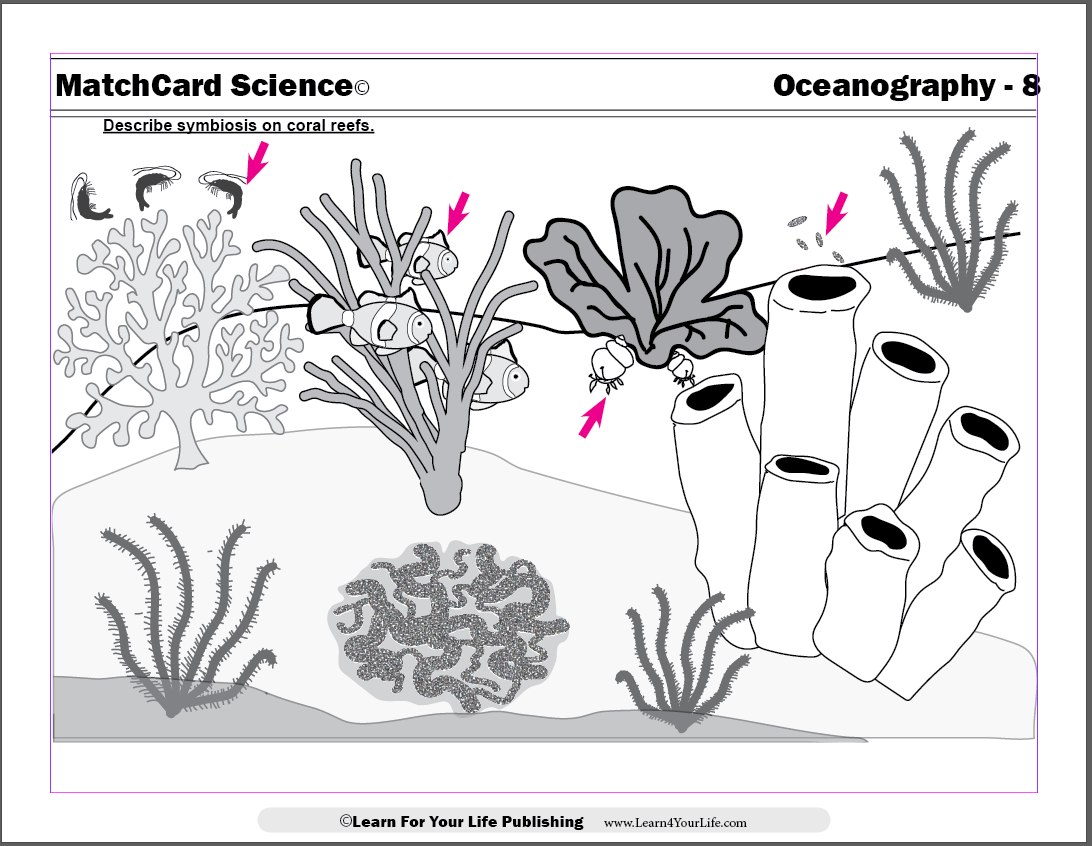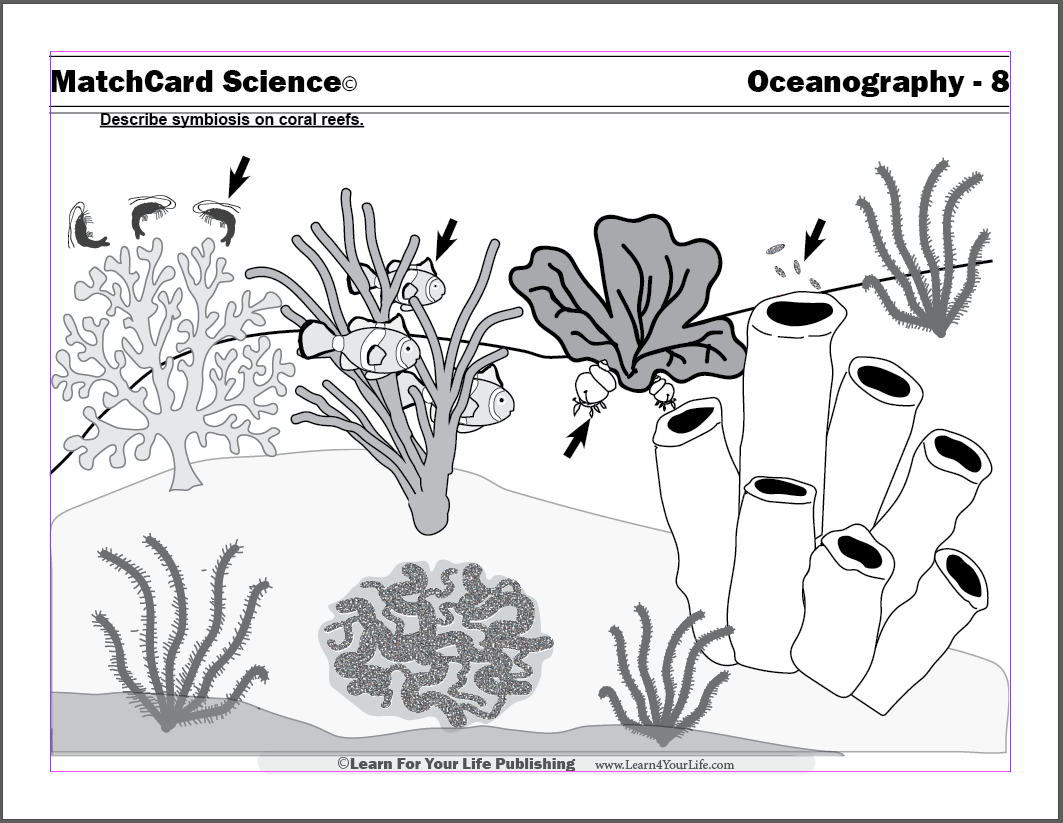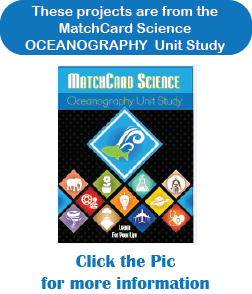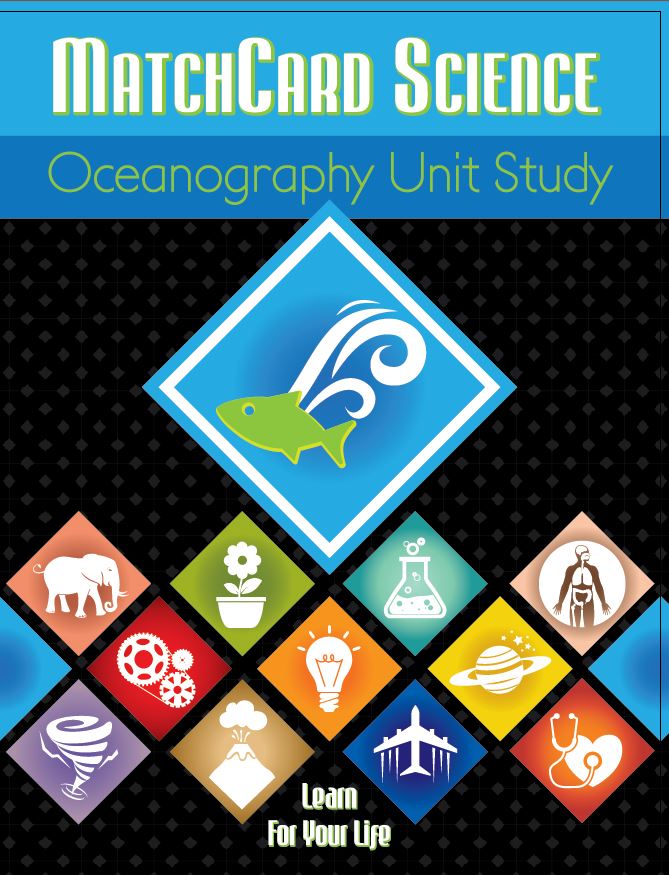Coral Reef

Describe the symbiosis on a coral reef.
This Coral Reef Worksheet is from MatchCard Science Oceanography Unit Study for grades 3 - 8. Students desccribe four examples of symbiosis involving shrimp, anemone fish, hermit crabs, and algae.
Free Download Below


MatchCard Science Coral Reef Worksheet
Objective: Differentiate between algae and plants.MatchCard: Download below.
MatchCard Information Pieces describe specific example of symbiosis in a coral reef. Ideas for projects are listed on the instructor's page and below.
Print Your Free Copy of the Coral Reef MatchCard
This is MatchCard #8 of the Oceanography Unit Study. More information on the MatchCard Science curriculum is at the bottom of this page.What is a Reef?
Is it a rock? A Plant?
Many of the reefs are hard and tall. But they aren’t rocks. They are alive. So what could they be?Plants are alive, and some (like trees) are hard. Do you think the coral reef is a plant?
It is actually an amazing colony of non-mobile animals.
Learn About Polyps
A polyp is a simple animal. It is from the phylum Cnidaria. (You learn about animal phyla in the MatchCard ScienceZoology Unit Study.) Jellyfish are in the same phylum and are similar to the polyps.Each polyp has a simple body structure: basically a sac with one opening. That opening takes food in AND excretes waste. Around that opening a series of tentacles protrude. Those tentacles sting the polyps' prey, paralyze it, and draw it into the single hole for digestion. Not very nice, is it?
Different species of polyps are different sizes. The largest might be two feet tall. Most of them will only be about two or three centimeters (or about one inch.)
This little polyp isn’t floating around the ocean looking for trouble, however. A colony of thousands of polyps binds together to form a reef. The reef is anchored to the bottom of the ocean so the polyp becomes immobile.
Most polyps are nocturnal: feeding during the night and resting during the day. How does a sac sleep? It draws its tentacles into the reef and waits for the next feeding period.
The Top of the Polyp
Many of the hard corals are ancient creatures. The reef may be as tall as one hundred feet. Only the polyps on the top one or two feet are still alive; the others are the skeletal remains of polyps that lived and died previously.How big is one hundred feet? If you estimate one story to be ten feet, a one hundred foot building is ten stories. If each story is fifteen feet, it would be only six stories; but that’s pretty tall for a colony of two centimeter animals.
Crafty Science: Make a Polyp Tower and Scenery
Supplies:- Bathroom cups (alternatives: egg carton cut into twelve cups; or bottle caps)
- Spray paint or tempra paint
- Colored Glitter glue (your color choice)
- Spray or paint your polyps. Glue them together in a tower with the glitter glue.
As an alternative: learn about other animals. Print pictures of them off the internet or draw and color them yourself. Add them to your reef.
Symbiosis on a Coral Reef
Symbiosis is a relationship between two organisms that benefits them both. Coral reefs are environments that depend on symbiosis. We will learn about four different symbiotic relationships. Keep in mind that there are hundreds more.Algae and Coral: Symbiosis #1
Algae play an extremely important role in the reef. The flecks of algae would be quickly consumed by predators; so they hide in the space between the individual polyps on the reef. There the grasping tentacles of the polyps keep the algae’s predators away.
In exchange for the protection, the algae provide some important functions for the reefs. Since algae turn carbon dioxide into oxygen, they provide the oxygen for the coral reefs. The bright colors of the algae create the colors of the reef. Some algae even bring biolumensence to the reef. The algae also help in the production of calcium carbonate - or limestone. To better understand the importance of limestone, let’s look at two main types of coral: hard and soft.
Hard Coral
Calcium Carbonate
If you have studied MatchCard Science Chemistry Unit Studyyou may recognize that calcium carbonate is a molecule made up of calcium and carbon atoms.
Do you know anything made out of calcium carbonate? Are you familiar with any of these:
- limestone
- chalk
- Tums
- egg shells
- chicken bones
Chemistry and Carbon on the Coral Reef
Just to whet your appetite for the Chemistry Unit Study, let’s do a little demonstration that shows what happens on a reef. Drop a piece of chalk or Tums into vinegar. It will bubble and fizz and leave the calcium molecules behind at the bottom of the jar. Pour some baking soda into the cup and stir and it returns to calcium carbonate.
You can try the same thing with pieces of egg shells (leave them as large as you can.) It will take several hours for the change to take place. Hold the egg shells in your hand and look through them. That calcium carbonate is pretty important stuff: to the chicken bones, to the egg shell, to the chalk - and to the hard coral reefs.
Do you agree that this symbiotic relationship works pretty well? The polyps protect the algae and give it a residence.
The algae provide oxygen, color, and help form that hard calcium carbonate exoskeleton.
Anemones: Symbiosis #2
What Is A Sea Anemone? They are associated with coral reefs but there can be confusion on whether it is a flower, another type of reef, or a fish. Actually, there are three different uses of anemone, and if you ever start your own Coral Reef Dictionary, you will want to include all three.
Anemone Flower
These are land plants that have nothing to do with coral reefs. They come in a variety of bright reds and blues. Check out some pictures of them when you have a chance.
Sea Anemone
These beauties ARE part of coral reefs. Like polyps and jellyfish, they are Cnidaria with a sac-like body and stinging tentacles. They are larger than polyps and live as single animals or as groups that are more loosely joined than the polyp colonies. Their vibrant colors inspired the explorers who discovered them to name them after the unrelated anemone garden flower. Look up some pics and see if you think they look like the garden flowers.
Anemone Fish
And our final creature that bears the anemone name is the anemone fish, also named the clown fish. These famed fish proudly wear bright colors to boast their residence in the reefs.
What Is In A Name? Speaking of clown fish, there is a famous cartoon character whose name is located inside the word “anemone.”
Clown Fish and Coral - A Match Made in Heaven - or under the sea
The clown fish’s bright colors make them easy targets for hungry predators, but the stinging reefs offer them shelter. The clown fish has a special mucous membrane that prevents it from getting stung if touched by the tentacles, so it has a safe haven living within the reef. In return for protection it offers the corals something they need. While the clown fish is contentedly nibbling the meals it brings back to the reef, it drops pieces the polyps and sea anemones grab.
Maybe you have a dog that does the same thing. Hey, the polyps need food too, and since they are immobile their fish-buddies bring it to them. Sounds like a good example of symbiosis to me.
Hermit Crab: Symbiosis #3
The hermit crab is another creature of the ocean deep that is looking for protection from predators. It finds an abandoned shell of a dead snail and claims it as its own personal mobile home. The crab loves to live beneath the reefs where the colors and shade provide camoflauge for the hiding hermit.
In exchange, the mobile hermit crab supplies food to the immobile reef.
Shrimp: Symbisosis #4
Shrimp are another creature that live in the cracks and crevices of coral reefs to hide from predators. In return the shrimp clean and filter the reef.
Clean and filter? Did you know shrimp provide personalized maid service at the bottom of the sea?
Value of our Coral Reefs
Here are some of the ways coral reefs benefit humans and other terrestrial animals:
- prevent shore erosion
- remove carbon dioxide from the atmosphere
- provide food for the fishing industry
- provide drugs - including new cancer drugs
- beauty and diversity of living creatures
- tourism and scuba diving attractions
- jewelry (look up pictures of coral jewelry)
Which of the benefits of the coral reef do you think are the most important?
Coral Jewelry & Ethics
Coral jewelry has been found since ancient times. Some are opposed to coral being harvested today for jewelry since the coral reefs are in danger of destruction. What do you think?
Is it a good idea or bad idea for people to create man-made coral reefs in order to harvest jewels or other products?
Coral Reef Tanks
For the highly committed enthusiast, creating and mainting a coral reef tank might be a rewarding challenge. These aquarium projects take much more time and money than regular freshwater aquariums. How would you like to have a colorful reef in your living room?
Other Coral Reef Projects
Check out the cost of coral plants to include in a coral reef. It could get a bit expensive.
Check out the cost of coral jewelry on the Internet. Consider making artificial coral jewelry or artificial coral plants for a terarium or acquarium.
Raise shrimp or hermit crabs. What plants are available on the Internet or at your local acquarium for them?
Three Types of Coral Reefs
Those of you who would like to do more research on oceans and coral reefs might like to delve further into the three different types of reefs.
- Fringing Reef - right off the coast
- Barrier Reefs - miles from a coastline
- Atolls - around sunken volcanic island
Do you know anything made out of calcium carbonate? Are you familiar with any of these:
- limestone
- chalk
- Tums
- egg shells
- chicken bones
Chemistry and Carbon on the Coral Reef
Just to whet your appetite for the Chemistry Unit Study, let’s do a little demonstration that shows what happens on a reef. Drop a piece of chalk or Tums into vinegar. It will bubble and fizz and leave the calcium molecules behind at the bottom of the jar. Pour some baking soda into the cup and stir and it returns to calcium carbonate.You can try the same thing with pieces of egg shells (leave them as large as you can.) It will take several hours for the change to take place. Hold the egg shells in your hand and look through them. That calcium carbonate is pretty important stuff: to the chicken bones, to the egg shell, to the chalk - and to the hard coral reefs.
Do you agree that this symbiotic relationship works pretty well? The polyps protect the algae and give it a residence.
The algae provide oxygen, color, and help form that hard calcium carbonate exoskeleton.
Anemones: Symbiosis #2
What Is A Sea Anemone? They are associated with coral reefs but there can be confusion on whether it is a flower, another type of reef, or a fish. Actually, there are three different uses of anemone, and if you ever start your own Coral Reef Dictionary, you will want to include all three.Anemone Flower
These are land plants that have nothing to do with coral reefs. They come in a variety of bright reds and blues. Check out some pictures of them when you have a chance.Sea Anemone
These beauties ARE part of coral reefs. Like polyps and jellyfish, they are Cnidaria with a sac-like body and stinging tentacles. They are larger than polyps and live as single animals or as groups that are more loosely joined than the polyp colonies. Their vibrant colors inspired the explorers who discovered them to name them after the unrelated anemone garden flower. Look up some pics and see if you think they look like the garden flowers.Anemone Fish
And our final creature that bears the anemone name is the anemone fish, also named the clown fish. These famed fish proudly wear bright colors to boast their residence in the reefs.What Is In A Name? Speaking of clown fish, there is a famous cartoon character whose name is located inside the word “anemone.”
Clown Fish and Coral - A Match Made in Heaven - or under the sea
The clown fish’s bright colors make them easy targets for hungry predators, but the stinging reefs offer them shelter. The clown fish has a special mucous membrane that prevents it from getting stung if touched by the tentacles, so it has a safe haven living within the reef. In return for protection it offers the corals something they need. While the clown fish is contentedly nibbling the meals it brings back to the reef, it drops pieces the polyps and sea anemones grab.Maybe you have a dog that does the same thing. Hey, the polyps need food too, and since they are immobile their fish-buddies bring it to them. Sounds like a good example of symbiosis to me.
Hermit Crab: Symbiosis #3
The hermit crab is another creature of the ocean deep that is looking for protection from predators. It finds an abandoned shell of a dead snail and claims it as its own personal mobile home. The crab loves to live beneath the reefs where the colors and shade provide camoflauge for the hiding hermit.In exchange, the mobile hermit crab supplies food to the immobile reef.
Shrimp: Symbisosis #4
Shrimp are another creature that live in the cracks and crevices of coral reefs to hide from predators. In return the shrimp clean and filter the reef.Clean and filter? Did you know shrimp provide personalized maid service at the bottom of the sea?
Value of our Coral Reefs
Here are some of the ways coral reefs benefit humans and other terrestrial animals:- prevent shore erosion
- remove carbon dioxide from the atmosphere
- provide food for the fishing industry
- provide drugs - including new cancer drugs
- beauty and diversity of living creatures
- tourism and scuba diving attractions
- jewelry (look up pictures of coral jewelry)
Coral Jewelry & Ethics
Coral jewelry has been found since ancient times. Some are opposed to coral being harvested today for jewelry since the coral reefs are in danger of destruction. What do you think? Is it a good idea or bad idea for people to create man-made coral reefs in order to harvest jewels or other products?Coral Reef Tanks
For the highly committed enthusiast, creating and mainting a coral reef tank might be a rewarding challenge. These aquarium projects take much more time and money than regular freshwater aquariums. How would you like to have a colorful reef in your living room?Other Coral Reef Projects
Check out the cost of coral plants to include in a coral reef. It could get a bit expensive.Check out the cost of coral jewelry on the Internet. Consider making artificial coral jewelry or artificial coral plants for a terarium or acquarium. Raise shrimp or hermit crabs. What plants are available on the Internet or at your local acquarium for them?
Three Types of Coral Reefs
Those of you who would like to do more research on oceans and coral reefs might like to delve further into the three different types of reefs.- Fringing Reef - right off the coast
- Barrier Reefs - miles from a coastline
- Atolls - around sunken volcanic island
MatchCard Science
How To Use MatchCards

Download the FREE MatchCard Science Instructor's Guide and see how MatchCards can make building their science knowledge base fun.
Ocean Unit Study

12 Science Unit Studies

Chemistry is only one of twelve complete unit studies for kids in 3rd to 8th grade.
Comprehensive objectives, hands-on projects, suggested science fair experiments, and the fun game-like MatchCards keep them interested in learning science. See all twelve MatchCard Science Unit Studies.
About Our Site
Hands-On Learning














